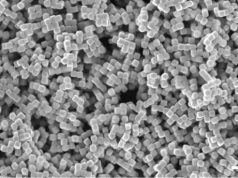DNA is the blueprint of biological life: it contains all hereditary information and the arrangement of its base pairs determines the structure of amino acids and ultimately the whole organism.(stock image)
Credit: © MG / Fotolia
Engineers of Friedrich-Alexander Universität Erlangen Nürnberg (FAU) have succeeded in producing complex crystal lattices, so-called clathrates, from nanoparticles using DNA strands. The programmed synthesis of clathrates represents a template for the precision modelling of novel nanomaterials.
DNA determines lattice structure
For the synthesis process, the 250 nanometre gold crystals — which in the experiment represent atoms that can form clathrates — are held in a suspension which is supplemented with artificial DNA. ‘The DNA strands attach to the gold particles and move them into a certain position during a self-assembling process,’ explains Professor Michael Engel, member of the Institute for Multiscale Simulation. ‘Depending on the length of the DNA sequences and the arrangement of the base pairs, different three-dimensional lattice structures form. Through DNA programming we can more or less determine the structure of the crystal lattice in a very precise manner.’
Clathrates — nuclear cages with a wide range of applications
Find your dream job in the space industry. Check our Space Job Board »
Clathrates are of particular interest in the field of materials research because they are composed of nuclear cages in which other substances, usually gases, can be embedded. ‘The controlled production of colloidal clathrates opens up a wide range of possible applications,’ says Michael Engel. ‘Materials could be used for recognising proteins or viruses and targeted manipulation of certain parameters of the crystal lattice can lead to material properties which are not achievable in simpler colloidal crystals.’
Sources:University of Erlangen-Nuremberg











